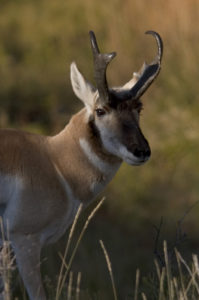Guest Blog by Ben Wise | Biologist – Wyoming Game and Fish
Pronghorn Antelope can be found throughout the grasslands and sagebrush landscapes of the valley and have a long history of finding ways to survive in the harsh landscapes of western North America. Pronghorn are are the last remaining member of the family Antilocapridae, with their closest living relatives being giraffes and okapi (both of Africa) and are one of the last remaining unchanged North American terrestrial mammals from the Pleistocene era. Pronghorn are the fastest terrestrial mammal in North America and evolved over-sized heart, trachea and lungs to enhance the ability to reach speeds of up to 55 mph over short bursts and sustained running at greater than 35 mph for four miles or more. Their long, light skeletal structure reduces stress on joints during sustained sprints and their hooves have large cartilaginous pads that act as shock absorbers while running over rocky, uneven terrain. This incredible speed was essential to evade prehistoric North American predators including two species of cheetahs, dire wolves, short faced bears and saber-toothed cats as well as modern predators including coyotes, mountain lions and bobcats. Other adaptations essential to survival on the open grasslands include incredible eyesight due to oversize, protruding eyes (roughly the same size as an African elephant) that allow them a 320 degree field of vision and the ability to detect movement up to 4 miles away. Hollow hair which is both light weight and incredibly efficient for both warming in the winter and cooling in the summer is also easily pulled out, allowing pronghorn an additional line of defense if caught by a predator. Finally, pronghorn antelope derive their name from the unique forked horns that both male and females grow, with males producing much larger horns. These horns are a combination of both horns and antlers with interesting qualities of both. True antlers are made of bone, grow throughout the spring and summer and are shed in the late winter of each year. True horns posses a bony core over which dense keratin grows and neither the bone or the outer core is shed during the life of the animal. Pronghorn are unique in that they grow a black keratinous sheathe over a bony core (similar to a horn) and after the breeding season each fall, shed the sheaths and begin regenerating another set of sheaths for the following year (similar to antlers).
Every spring between 300-400 pronghorn antelope migrate from the windblown sagebrush flats of the Green River Valley, following the Gros Ventre River drainage down to Grand Teton National Park and surrounding lands to give birth and raise their offspring. As winter approaches, these hardy individuals with four month old fawns in tow leave the Jackson valley, often enduring early fall snow that has inevitably began accumulating on the mountain pass that separates their winter and summer habitats, and retrace this “Path of the Pronghorn” as they have done for millennia.

